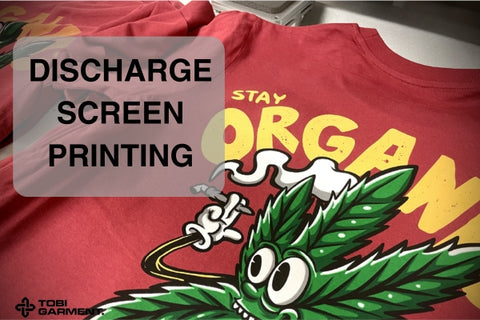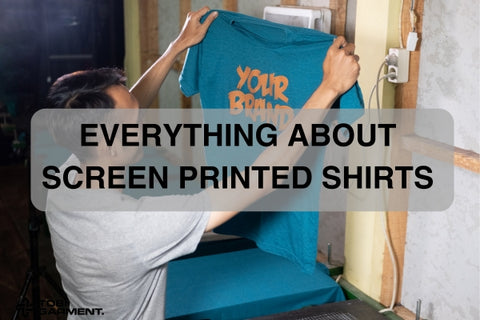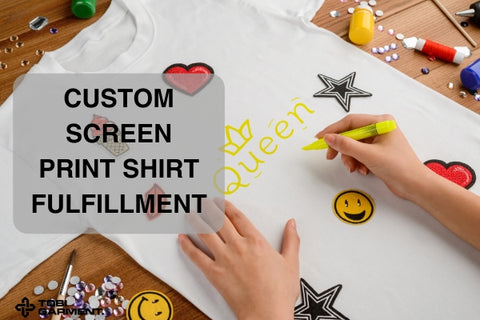
One of the most popular techniques used for this is discharge screen printing. It's a process that involves removing color from fabric, leaving behind a beautiful, crisp design. In this comprehensive guide, we'll explore the world of discharge screen printing, from understanding the basics to mastering the techniques.
Understanding Discharge Screen Printing
What is Discharge Screen Printing?
Discharge screen printing is a unique method that works by chemically removing color from fabric. Unlike traditional screen printing, which adds color to the fabric, discharge printing subtracts color, resulting in a soft, almost vintage-like effect. This technique is particularly popular for creating designs on dark-colored fabrics, as the contrast between the removed color and the original fabric color is striking.
How Does Discharge Screen Printing Work?
The process of discharge screen printing involves several steps:
- Fabric Preparation: The fabric is prepared by washing and pre-treating it to ensure optimal color removal.
- Stencil Creation: A stencil is designed and created to match the desired design.
- Ink Application: A special discharge ink is applied to the fabric through the stencil using a squeegee.
- Color Removal: The discharge ink chemically reacts with the fabric, removing the color in the areas covered by the stencil.
- Curing: The printed fabric is cured to set the design and ensure colorfastness.
Benefits of Discharge Screen Printing
- Soft Handfeel: Discharge printed designs often have a softer feel compared to traditional screen printing, making them more comfortable to wear.
- Vivid Colors: The contrast between the removed color and the original fabric can create stunning, vibrant designs.
- Durability: Discharge printed designs are generally durable and can withstand multiple washes without fading.
- Versatility: This technique can be used on a variety of fabrics, including cotton, polyester, and blends.
- Eco-Friendliness: Some discharge inks are considered more environmentally friendly than traditional inks.
Read more: Screen Printing Hoodies: A Step-by-Step Tutorial for DIY Enthusiasts
Applications of Discharge Screen Printing
Discharge screen printing is used in a wide range of applications, including:
- Apparel: T-shirts, hoodies, hats, and other clothing items.
- Home Decor: Pillows, curtains, table linens, and wall art.
- Promotional Items: Bags, tote bags, and custom merchandise.
- Industrial Products: Workwear, uniforms, and safety apparel.
Choosing the Right Fabric for Discharge Screen Printing
Best Fabrics for Discharge Printing
- Cotton: Cotton is one of the most popular fabrics for discharge printing due to its natural fibers and excellent color absorption.
- Polyester: Polyester can also be used for discharge printing, but it may require different pre-treatment and curing methods.
- Blended Fabrics: Blends of cotton and polyester can offer a balance of softness and durability.
Factors to Consider When Selecting Fabric
- Fabric Weight: Heavier fabrics may require different ink formulations and curing times.
- Fiber Content: The fiber content of the fabric can affect how the discharge ink reacts.
- Pre-Treatment Requirements: Some fabrics may need to be pre-treated before discharge printing to ensure optimal results.
Pre-Treating Fabrics for Discharge Printing
- Washing: Wash the fabric to remove any impurities that may interfere with the printing process.
- Sizing: Some fabrics may require sizing to improve ink adhes
Read more: Start Screen Printing T-Shirts at Home: A Simple Guide
Selecting the Best Ink for Discharge Screen Printing
Types of Discharge Inks
- Pigment Discharge: Pigment discharge inks contain pigments that are removed from the fabric, leaving behind a white or light-colored design.
- Reactive Discharge: Reactive discharge inks chemically react with the fabric fibers, removing color and creating a more permanent design.
Factors to Consider When Choosing Ink
- Colorfastness: Ensure the ink is colorfast to prevent fading over time.
- Opacity: The opacity of the ink will determine how well the design will show up on the fabric.
- Viscosity: The viscosity of the ink can affect its application and drying time.
- Curing Temperature: Different inks may require different curing temperatures.
Ink Preparation and Application
- Mixing: Follow the manufacturer's instructions for mixing the ink to the desired consistency.
- Filtering: Filter the ink to remove any impurities that may clog the stencil.
- Application Techniques: Use a squeegee to apply the ink to the fabric through the stencil.
The Screen Printing Process: Step-by-Step Guide
Setting Up the Screen Printing Station
- Equipment Setup: Assemble the necessary equipment, including a screen printing press, screens, squeegees, and a curing unit.
- Workspace Preparation: Ensure your workspace is clean and well-lit.
Preparing the Stencil
- Stencil Design: Create a design for your stencil using computer software or traditional methods.
- Stencil Exposure: Expose the stencil to light to create the desired design.
- Stencil Washing: Wash the stencil to remove any unexposed emulsion.
Applying Ink to the Fabric
- Flood the Screen: Pour the ink onto the screen, ensuring it covers the entire surface.
- Squeegee Application: Use a squeegee to force the ink through the stencil onto the fabric.
- Multiple Passes: For more intense color removal, you may need to make multiple passes with the squeegee.
Curing the Printed Design
- Curing Methods: Use a curing unit or heat press to cure the printed design.
- Curing Temperature and Time: Follow the manufacturer's recommendations for curing temperature and time.
Finishing Touches
- Washing: Wash the printed fabric to remove any excess ink and chemicals.
- Ironing: Iron the fabric to set the design and ensure it doesn't shrink or distort.
Finishing Processes
- Heat Transfer: For a more durable finish, you can apply a heat transfer vinyl layer to the printed design.
- Embroidery: Combine discharge printing with embroidery for a unique and textured effect.
Read more: Everything You Need to Know About Screen Printed Shirts
Discharge Screen Printing vs. Other Printing Methods
Comparison with Sublimation Printing
- Fabric Compatibility: Sublimation printing is typically better suited for polyester fabrics, while discharge printing can be used on a wider range of materials.
- Color Gamut: Sublimation printing offers a wider color gamut, while discharge printing may have limitations in certain color combinations.
- Durability: Discharge printing generally offers better durability than sublimation printing, especially when it comes to washing and fading.
Comparison with Digital Printing
- Production Time: Digital printing often has faster turnaround times compared to discharge screen printing, especially for smaller quantities.
- Cost: Digital printing can be more cost-effective for smaller orders, while discharge screen printing may be more economical for larger quantities.
- Design Complexity: Digital printing can handle more complex designs and gradients, while discharge screen printing may have limitations in terms of detail.
Comparison with Traditional Inkjet Printing
- Print Quality: Traditional inkjet printing offers high-resolution prints, while discharge screen printing may have slightly lower resolution.
- Application Versatility: Discharge screen printing is better suited for larger areas and fabrics, while inkjet printing can be used on a wider range of surfaces.
- Cost Per Print: Traditional inkjet printing can be more expensive per print compared to discharge screen printing, especially for larger quantities.
Read more: How to Screen Print Numbers on Jerseys Like a Pro
Conclusion
Discharge screen printing is a versatile and exciting technique that allows you to create unique and eye-catching designs. By understanding the process, selecting the right materials, and following the steps outlined in this guide, you can achieve professional-quality results. Whether you're a hobbyist or a business owner, discharge screen printing offers endless possibilities for creativity and expression.
FAQ
1. Can I discharge print on polyester?
Yes, you can discharge print on polyester, but it may require different pre-treatment and curing methods.
2. What is the difference between discharge printing and screen printing?
Discharge printing removes color from the fabric, while traditional screen printing adds color.
3. Can I use a home screen printing press for discharge printing?
Yes, you can use a home screen printing press for discharge printing, but you may need to adjust the pressure and temperature settings.
4. How do I choose the right discharge ink for my project?
Consider factors such as colorfastness, opacity, viscosity, and curing temperature when selecting an ink.
Read more related posts from Tobi Garment:



